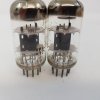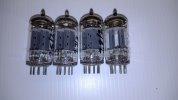StingRay85
Well-Known Member
- Joined
- Aug 18, 2019
- Messages
- 3,435
- Reaction score
- 3,694
This is common knowledge. RFT is actually not a company but was a collection of companies in East Germany. Some had codes printed on the bottom of the base, some didnt't. I have about 100 of those RFT, about 40 of them new in box. From all the different types of EL34 I have, what strikes me the most is that the pins are such high quality that you never see damage or corrosion on them. The design was afterwards copied by Electro-Harmonix, where it is still in use. Just like Philips, Siemens had acid etched codes on each indivual tube. Their high quality tubes (E83CC, E88CC, E84L) used different codes. Siemens stopped quite early making preamp tubes, and sourced them from Ei. Siemens never made EL34 or GZ34. Ei made a EL34 with a pointy top, but it was not a big success
Last edited:









